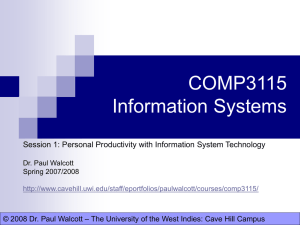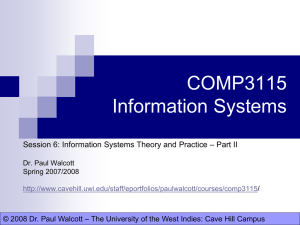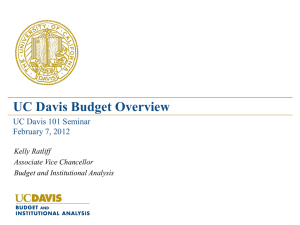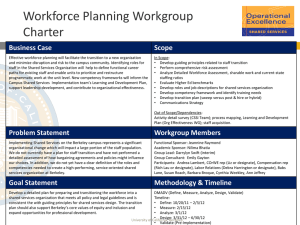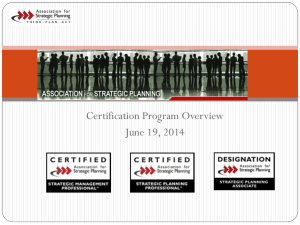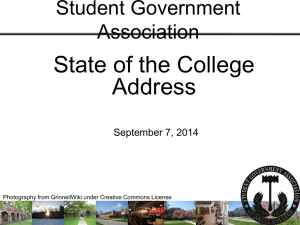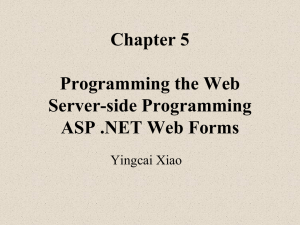script - The University of the West Indies
advertisement
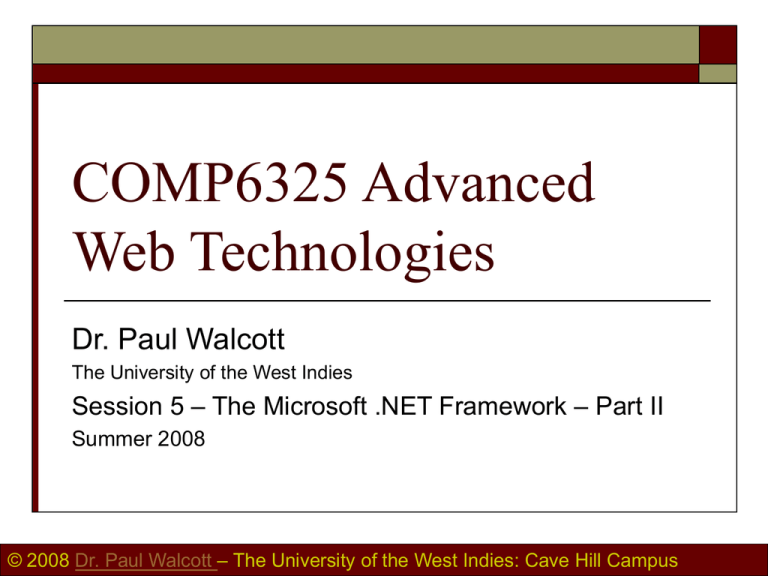
COMP6325 Advanced
Web Technologies
Dr. Paul Walcott
The University of the West Indies
Session 5 – The Microsoft .NET Framework – Part II
Summer 2008
© 2008 Dr. Paul Walcott – The University of the West Indies: Cave Hill Campus
Objectives
In this session the student will:
Describe the ASP.NET framework
Install ASP.NET
Create an ASP.NET application
© 2008 Dr. Paul Walcott – The University of the West Indies: Cave Hill Campus
Motivation
(Platt 2003)
In the early days of the web, servers delivered
static web pages
Written using HTML and CSS
Static pages do not work, however when users
want to make ad hoc queries to a system
© 2008 Dr. Paul Walcott – The University of the West Indies: Cave Hill Campus
Motivation cont’d
A dynamic system requires:
Program logic associated with page requests
User input, system output
User identification
User session management
© 2008 Dr. Paul Walcott – The University of the West Indies: Cave Hill Campus
What is ASP.NET?
“ASP.NET is a sever-side framework for
developing Web applications based on the
Microsoft .NET Framework.”
(Yank 2002)
© 2008 Dr. Paul Walcott – The University of the West Indies: Cave Hill Campus
What is ASP.NET cont’d?
ASP.NET provides:
State management
Security
Save to server or database
Through Microsoft Passports or prefabricated
authentication schemes
Abstraction away from HTML
Through Web forms and ASP.NET sever controls
(web forms treated like desktop applications)
© 2008 Dr. Paul Walcott – The University of the West Indies: Cave Hill Campus
What is ASP.NET cont’d?
ASP.NET has all of the benefits of the .NET
framework
For example it supports multiple languages
The program logic and HTML output are
separated in ASP.NET, making it easier to
program and maintain
© 2008 Dr. Paul Walcott – The University of the West Indies: Cave Hill Campus
Popularity of ASP.NET
Several web sites have been created using
ASP.NET including:
www.Match.com
© 2008 Dr. Paul Walcott – The University of the West Indies: Cave Hill Campus
Activity
Install ASP.NET and the Microsoft Internet
Information Service (IIS)
Use the following resources to help you:
http://www.sitepoint.com/print/asp-dot-netintroduction
http://www.sitepoint.com/print/getting-started-asp-net
© 2008 Dr. Paul Walcott – The University of the West Indies: Cave Hill Campus
Activity cont’d
Installing ASP.NET
Open a command window and type:
C:\WINDOWS\Microsoft.NET\Framework\v2.0.50
727\ aspnet_regiis.exe -i
© 2008 Dr. Paul Walcott – The University of the West Indies: Cave Hill Campus
Activity cont’d
Installing Microsoft Internet Information
Services (IIS)
Open the Control Panel
Double mouse click on Add or Remove Programs
On the right-hand side of the Add or Remove Program
(that appears) click the Add/Remove Windows
Component icon
Scroll down the list of components that appear and select
Internet Information Services (IIS)
follow the installation instructions
© 2008 Dr. Paul Walcott – The University of the West Indies: Cave Hill Campus
Activity cont’d
Configuring Microsoft IIS
Open the control panel
Double-click the Administrative Tools icon
Double-click the Internet Information Services Icon.
Select the Home Directory tab and set the location of the
root directory to your website
Change the port address to 8080
To test type http://localhost:8080/first.aspx
Note the file first.aspx needs to be placed in the root directory of
your website
© 2008 Dr. Paul Walcott – The University of the West Indies: Cave Hill Campus
Activity cont’d
Use this program to test your installation
<%@ Page Language="C#" %>
<html>
<head>
<title>My First ASP.NET Page</title>
<script runat="server">
protected void Page_Load(Object Source, EventArgs E)
{
TimeLabel.Text = DateTime.Now.ToString();
}
</script>
</head>
<body>
<p>The time is: <asp:label runat="server" id="TimeLabel" /></p>
</body>
</html>
© 2008 Dr. Paul Walcott – The University of the West Indies: Cave Hill Campus
ASP.NET page anatomy
ASP.NET pages are text files with an aspx extension
When a browser requests an ASP.NET page, the ASP.NET
runtime (as a component of the .NET Framework's Common
Language Runtime, or CLR) parses and compiles the target
file into a .NET Framework class. The application logic now
contained within the new class is used in conjunction with the
presentational HTML elements of the ASP.NET page to
display dynamic content to the user.
(Ruvalcaba 2004b)
© 2008 Dr. Paul Walcott – The University of the West Indies: Cave Hill Campus
ASP.NET page anatomy cont’d
Some of the elements that make up an
ASP.NET page include:
Directives
Code declaration blocks
Code render blocks
Server-side comments
© 2008 Dr. Paul Walcott – The University of the West Indies: Cave Hill Campus
Directives
Directives control compilation, specify
settings, allow debugging and importing of
classes
Page directive – specifies the language
<%@ Page Language=“C#” %>
Import directive – imports classes/namespaces
<%@ Import
Namespace=“System.Web.Mail” %>
© 2008 Dr. Paul Walcott – The University of the West Indies: Cave Hill Campus
Code declaration blocks
Contains the application logic for the page
External code pages may also be specified in the
script tag:
<script runat=“server”>
void method(){
// code
}
</script>
© 2008 Dr. Paul Walcott – The University of the West Indies: Cave Hill Campus
Code declaration blocks cont’d
Note script tags can also have a language and
src attribute
Specifies the language of the script
Specifies an external file for the script
<script runat=“server”
language=“C#” src=“file.cs”>
…
</script>
© 2008 Dr. Paul Walcott – The University of the West Indies: Cave Hill Campus
Comments
Comments are specified by // or /* … */
in C#
To prevent items from being processed by
ASP.NET use server-side comments
<%-- comment --%>
© 2008 Dr. Paul Walcott – The University of the West Indies: Cave Hill Campus
Code render blocks
Used to define inline code and is executed
when it is encountered
There are two types
Inline code
<% string name=“Bob Smith”; %>
Inline expressions
<% = name%>
© 2008 Dr. Paul Walcott – The University of the West Indies: Cave Hill Campus
Activity
Read the following chapter:
http://sitepoint.com/print/vb-dot-net-c-sharpprogramming
© 2008 Dr. Paul Walcott – The University of the West Indies: Cave Hill Campus
Activity
Create a form that accepts the personal
information of an individual and validate it
using ASP.NET
© 2008 Dr. Paul Walcott – The University of the West Indies: Cave Hill Campus
Conclusion
In this session
The ASP.NET framework was described
A simple ASP.NET application was developed
© 2008 Dr. Paul Walcott – The University of the West Indies: Cave Hill Campus
References
Platt, D., “Introducing Microsoft .NET”, Third Edition, Microsoft Press, 2003
Ruvalcaba, Z., “Build Your Own ASP.NET Website Using C# And VB.NET, Chapter 1 –
Introduction to .NET and ASP.NET”, 2004. Available online at
http://www.sitepoint.com/print/asp-dot-net-introduction
Ruvalcaba, Z., “Build Your Own ASP.NET Website Using C# And VB.NET, Chapter 2 – ASP.NET
Basics”, 2004. Available online at http://www.sitepoint.com/print/asp-dot-net-basics
Yank, K., “Getting Started with ASP.NET”, 2002. Available online at
http://www.sitepoint.com/print/getting-started-asp-net
© 2008 Dr. Paul Walcott – The University of the West Indies: Cave Hill Campus

